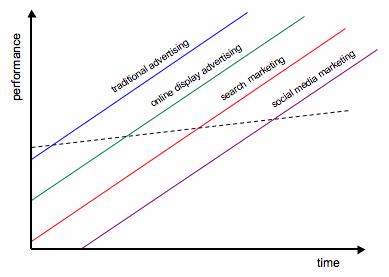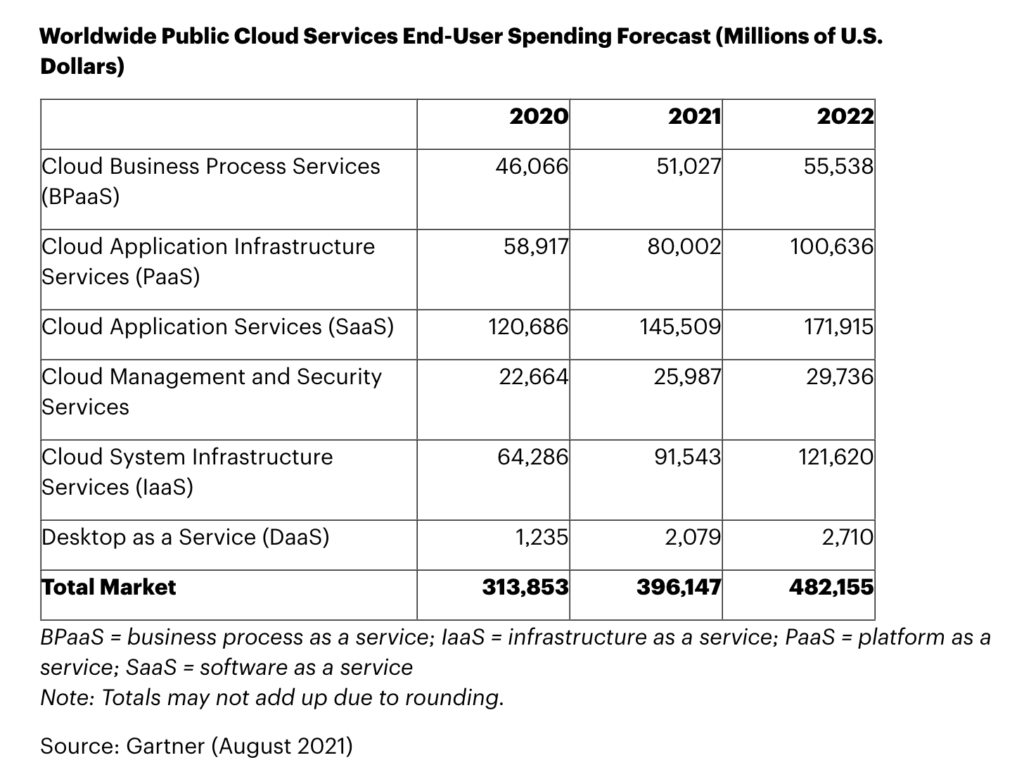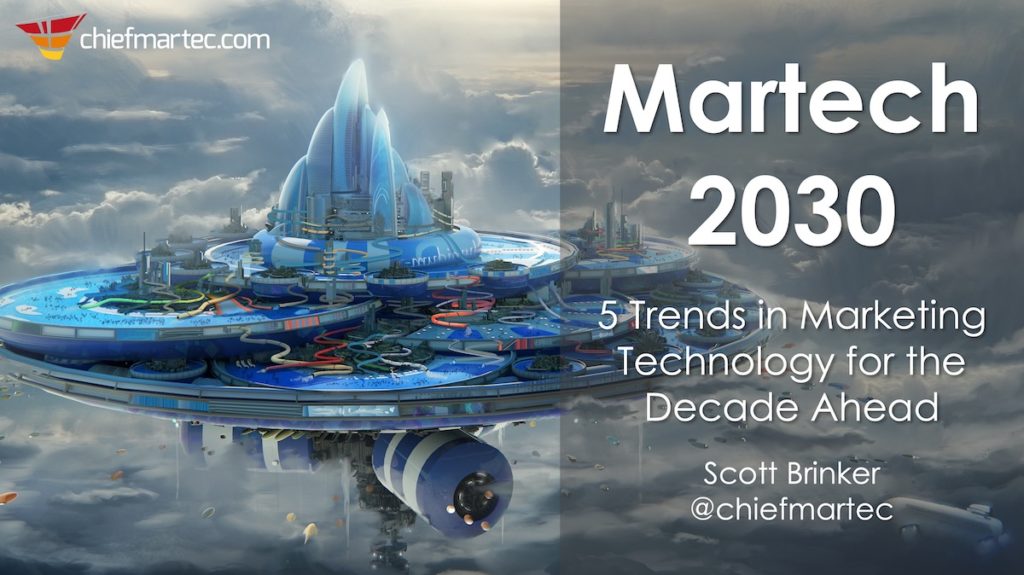Are the creative capabilities of major advertising agencies really being disrupted by online marketing? Here’s one theory.
Clay Christensen, Harvard Business School professor and author of bestselling books such as The Innovator’s Dilemma and The Innovator’s Solution, has a model for disruptive innovation. As a particular type of product or service improves over time, its “performance” — i.e., how powerful it is along a certain dimension of capability that buyers care about — eventually overshoots the needs of most customers (shown as a dotted line in the image below).
Over time, new waves of products and services — cheaper, but less sophisticated — arrive in the market and keep improving as well. These disruptive innovations almost always have less performance than the original “premium” product or service, which is why they are often underestimated by those original market leaders. But at some point, the performance of these lesser solutions becomes good enough — crossing that dotted line threshold of what is sufficient for the needs of the majority of customers. BAM! At that moment, the new disrupts the old, and droves of customers leap to the new solution.
In marketing, a key dimension of performance as shown above is “creative”, and the dotted line represents creative that is sufficient to attract customers and build a brand. Here we see 4 waves of disruptive innovation in advertising.
Traditional Advertising
Traditional advertising agencies have long been the bastion of creative talent: creative directors, art directors, graphic artists, copywriters. They are the wizards of the 30-second spot in TV and radio, the masters of lush 2-page spreads in Time and Newsweek. They’re a relatively scarce resource — very few people in marketing and business have their talent and experience in high-end ad design and production.
So those who could afford such traditional advertising ponied up for these high-end agencies. Those who couldn’t, well, they had to make do with second-tier creative or simply avoid TV and radio all together. It’s not really possible to hire “a little bit” of a high-end agency. In Christensen’s model, these customers left unserved are called non-consumers.
Online Display Advertising
Along comes the Internet, however, and with it a new type of advertising: online display advertising. Banners, animated images, and Flash ads became a new type of creative for attracting customers and building a brand on the web. Producing these ads required much less sophistication than Clio-winning TV spots, so more people were able to make them, and they were relatively cheap. Businesses (especially start-ups) that couldn’t afford TV could afford this. Somewhere along the way, these ads also became effective enough (remember the silly LowerMyBills.com dancers?) that major brands — even those who could afford high-end agencies for TV, print — were contracting with smaller digital shops to products cool but cheap banners.
There may be several dozen high-end traditional agencies (Ogilvy, JWT, Saatchi & Saatchi, etc.), but there are thousands of little digital agencies and niche web development firms that can produce sufficiently creative banners. You can even outsource the work to India or the Philippines — and you might be surprised by the quality.
In theory, you could have a high-end agency do banner ads, but their top creative people probably aren’t very interested in what they perceive as such low-end work. Besides, if they were to do the work, their talents (and associated costs) would far overshoot what was actually needed.
Search Engine Marketing
Then the real disruption hit: search engine marketing. Google’s text ads, which consist of a 25 character headline, two 35 character lines of text, and a 35 character display URL — a mere 130 characters total — became the new way to advertise on the web. Bid on a keyword, plug in a few short lines of text, and only pay for the people who click. Pay-per-click (PPC) search advertising is, relatively speaking, a cinch from a creative point of view. Almost anyone can create a Google AdWords ad.
Granted, creating good AdWords ads and developing an overall search marketing strategy requires more effort and talent. But it doesn’t require any graphic design or art direction at all. The notion of a Madison Avenue creative director being involved is outright ludicrous. These ad campaigns can be architected and implemented by a much broader set of marketing professionals, people not normally assigned the label of “creatives”, but rather account managers, marketing managers, and a new breed of search marketing professionals. Increasingly, these people are employees of the company doing the advertising, not an external agency — although there are certainly thousands of search agencies and contractors available to help.
[I should interject — with the disclosure that this is what my company, ion interactive, does — that the landing pages people are directed to when they click on search ads have much greater potential for creativity than the search ads themselves. Excellent storytelling, design, and interactive widgetry can all be brought to bear to craft phenomenal, creative post-click marketing landing experiences.]
Perhaps the most exciting and disruptive aspect of search marketing is that there are virtually no barriers for non-consumers. Any business with a credit card, an Internet connection, and a keyboard can place search engine ads in a matter of minutes — and be competing for the same keywords and placements as Fortune 500 brands.
Social Media Marketing
Now, the latest wave of disruptive innovation is social media marketing. As individual people talk about, share, recommend, hack, and flame products and services in blogs, social networks such as Facebook and MySpace, bookmark services such as del.icio.us and StumbleUpon, social news distributors such as Digg and Mixx, and other social sites with user-driven content such as Twitter, YouTube, FriendFeed, SezWho, Yelp, flickr, etc., these conversations are serving as a new kind of advertising to attract (or repel!) customers and build (or damage!) brands.
Even though there are so-called social media marketing firms — and many top agencies are excited about producing high-end “viral” videos and campaigns — the essence of social media marketing is arguably the antithesis of architected manipulation of the market through creative.
In the social sphere, it’s the customers and prospects themselves who are driving the conversation, and most of what a company can do is listen closely and respond when appropriate: to be active members in the relevant communities, but to have no illusion of control over those communities. In social media, it’s an inversion of advertising production as previously known: the customers are now the source of the creative, and companies are one of many consumers of it.
In other words, this kind of “being there” — authentically, genuinely — marketing doesn’t require much creative talent from a company or a hired agency. The best social media marketers for a company are the real staff of the company itself — its product engineers, customer service reps, managers at all levels — openly engaging with the world. Some community training and coordination is usually helpful, but no one has to go to design school.
To be sure, there are creative campaigns that now include social components. But the point (and the disruptive innovation) is that a company doesn’t need a high-end creative campaign to become highly visible and successful in the social sphere. Again, there are no barriers for previous non-consumers of creative services — even fewer than with search marketing — because most social media communities are free to participate in.
Conclusion
Each new wave of advertising here doesn’t necessarily obsolete the one before it — there will be TV and magazine ads for a while, and companies engaging in social media marketing are also growing their search marketing efforts. But it’s important to realize two points:
First, these new advertising paradigms are making effective promotion available to a much broader set of previous non-consumers — without the need for traditional creative — that levels the playing field in the digital landscape.
Second, there is only so much time, budget, and addressable market out there. If a company can use a new advertising paradigm to get customers more effectively, more efficiently, and less expensively, they will. Read about the Pepsi 25 social media rebranding campaign to see one example of a big traditional advertiser opting for social media marketing as its leading strategy.
Disruptive innovation at work in the marketing department.



